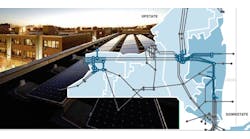The microgrid market is growing and, as it does, the definition of a microgrid is evolving, according to Aron Bowman, president of ELM Microgrid and ELM Solar. Bowman recently sat down with Rod Walton, managing editor of Microgrid Knowledge, to talk about the role microgrids can play in supporting electric vehicle (EV) charging as well as thermal microgrids, two of the most impactful growth areas he’s seeing in the market today.
EV charging and microgrids
The lack of EV charging infrastructure is a hot topic, Bowman said, as it’s a significant impediment to EV adoption. The primary roadblock for EV charger deployment right now is interconnection with the utility.
If a building traditionally has only used 250 kW of power, adding 20 EV chargers could double or triple the load, Bowman explained. “You can't just drop those chargers in and plug them in,” he added.
That’s why Bowman believes ELM is starting to see customers engaging with the company to support EV charging with microgrids.
Microgrids, especially when they include renewable energy such as solar, enable businesses to manage EV charging, reduce demand on the grid, lower energy costs by using stored energy during peak demand hours and improve overall resilience.
“You have a double whammy,” Bowman said. The microgrid’s energy storage supports your EV charging “but then also can support the operations of your business. So there's a lot of value there, especially with a renewable-based microgrid system.”
Renewable thermal solutions for microgrids
Solar thermal, a technology that converts sunlight into heat, is another area Bowman said ELM was seeing considerable interest and growth. “Solar thermal really is where the solar industry started” in the 1960s, ‘70s and ‘80s, he said. “There were quite a few solar thermal applications just basically heating up water for use.”
But, he explained, the technology didn’t catch on and was soon displaced by solar photovoltaics (PV), which convert sunlight directly into electricity. However, much has changed in the ensuing years, including the development of an innovative solar thermal tube by European company Naked Energy.
ELM has partnered with Naked Energy to deploy solar thermal systems in the U.S., including one at Creighton University. ELM installed a 22-kW solar array on one roof of Graves Hall, a freshman dormitory, and a 70-kW solar thermal solution on another. Solar thermal systems use sunlight more efficiently than solar PV – about 25% of the sun’s energy is captured with PV, whereas solar thermal captures upward of 75% – which means more energy can be generated in the same footprint, according to Bowman, who added that the system provides all the potable hot water for the building.
Next up, Bowman said, is a system that will have an “electrical solar panel integrated into the [solar thermal] tube that's still capturing heat. So now we're talking about capturing 95% of the sun's energy.”
Utilities are starting to think outside of the box
Walton and Bowman also discussed ELM’s role in a recently completed microgrid project for EPB, a regional utility in Chattanooga, Tennessee, and the Chattanooga police department. The project, which Bowman cited as just one example of a utility thinking outside the box when it comes to microgrids, created a utility-controlled microgrid that utilizes a front of the meter energy storage and microgrid system owned by the utility with a behind the meter, municipally owned rooftop solar array and generator located at a 911 call dispatch center.
“It's really exciting to see what can happen between the utility and the entities to really set up a fantastic resiliency situation for that key critical infrastructure for Chattanooga,” Bowman said.








